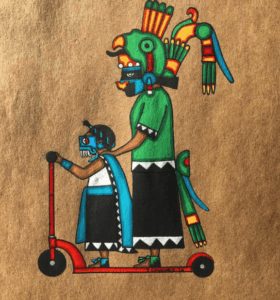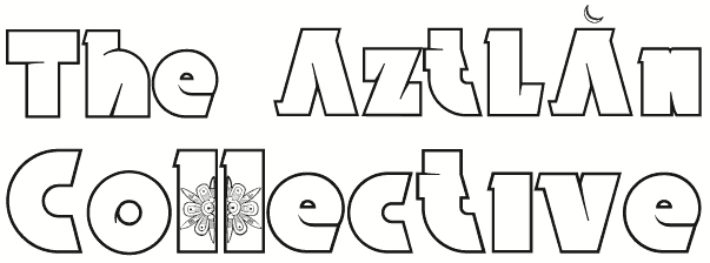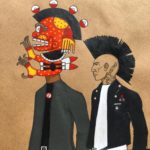Jaime Chavez inherited his predisposition to illustration from his father, but that is not the only thing he inherited. His work is unmistakably inspired by his indigenous ancestry. Huehuecoyotl, Tonantzin, Tochtli and Balam, among others, become masks/costumes/alter-egos for his subjects, usually people from his family or circle of friends. Chavez explains, “My culture, my barrio, my people, and every day life inspire me.” Chavez was born in Los Angeles and raised in Echo Park but has not lost touch of his Tarahumara and Papago nation (Tohono Oohodam) origins. He describes himself as a city Indian who apparently lives amongst a motley crew of punks, vatos, and Aztec Gods.
The artist uses toned paper as an homage to Mexican crafts, but is also fond of the way “the paint pops” against the brown. He buys his supplies from his favorite local hardware/art store. Black India ink, acrylics, Prisma colors and Rapidographs bring his characters to life. He showcases his detailed portraits, usually 2-3 per week, on his Instagram, which he personally maintains until he gets a website. His gallery is stunning, but it is also an interesting way of doing business. Chavez responds to each question, every accolade, and all comments are public.
Chavez was a teenager when the riots took over LA and martial law declared an enforced curfew. He has seen a lot of change in his neighborhood. Currently, the change come in the form on vegan restaurants, bars, and fancy boutiques. But to Chavez, gentrification is more than trendy new eateries, it is “the displacement of families and businesses.” This is not a race war though, the artist explains, “my neighborhood has always had white people living here. But the new white folks who have moved in have this vibe like ‘we own this now what are you doing here?’ There are a few good new folks who have moved in but overall, gentrification destroys the culture.”


His work is minimalist, yet very telling. In works like Lil Sisters, you can feel the bond between siblings; I had to ask about his relationship with his family. “I have a really close relationship with my familia. My Grandparents helped raise me and my brother. My Grandfather and Grandmother were big pachucos/as. My brother is my right-hand man, we are tight.”
“My mother passed away when I was 21 and my bro was 19. It was difficult for us, she did the best she could as a single parent. My dad was in the picture, but not as much as he should have been. I still love him though and we are pretty close.”
Recently, his work has been featured at Chimmaya Gallery in East Los Angeles and sold out. I asked Chaves about his collectors and he explained that he has work in collections “in Mexico, France, Canada, Slovenia, Japan, & PuertoRico,” although his collectors are “mostly Native Americans and Xicanos/Xicanas,” and even include Cheech Marin.

Follow Jamie Chavez on Instagram and support his work! Chavez uses the tag #deadonesdontneedit to point out the absurdity of people favoring established, often deceased, artists “when the living and struggling artists are in most need the support.” We agree and will adopt the hashtag!
Further reading:
About the author:
Diana Ledesma is an arts professional living in New York City. She obtained her masters from New York University in 2016, completing her thesis on the status of the Mexican American art market.






I just seen your work, and is very hot to the old nieghborhood in where I grew up also.
This is very powerful and should be eye opening to other hispanics among others.
Please email if you can more photos of your work. Very proud of you work. The outcome in the future that lays ahead for you will be very satisfying. Would love to see your work continue in a very large fashion, keep the power!
Kind Regards
Roland A Martinez